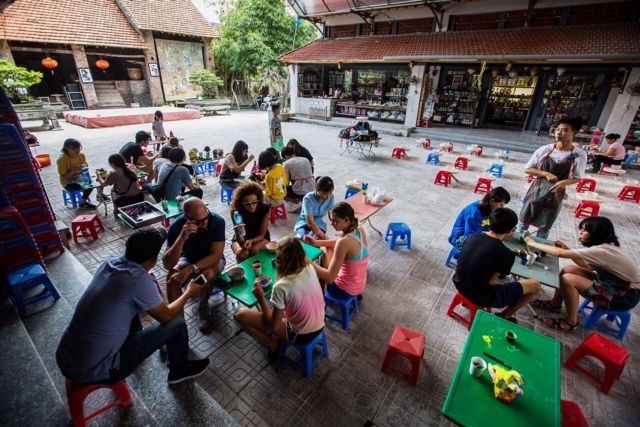 Society
Society

The city of Hà Nội is supporting traditional craft villages to help them modernise and invest in developing a technical infrastructure.

|
Foreign tourists make ceramics at the traditional ceramics village of Bát Tràng, Gia Lâm District. Photo Trọng Đạt
HÀ NỘI — The city of Hà Nội is supporting traditional craft villages to help them modernise and invest in developing a technical infrastructure.
It’s hoped this will help the many craft villages in the capital improve capacity and product quality.
Over the next three years, 50 development projects will be implemented at a number of villages including Bát Tràng Pottery Village (Gia Lâm), Vạn Phúc Silk Village (Hà Đông), and Sơn Đồng Handicrafts Village (Hoài Đức).
As the country opens up to international tourists, more and more visitors are expected to join in activities at the many craft villages dotted around the capital.
Statistics from the city’s Department of Agriculture and Rural Development reveal the total revenue from 318 craft villages was more than VNĐ20 trillion per year.
Each village has diverse products with beautiful designs, and good quality, with some exporting their items overseas.
Chairman of the Liên Hà Commune People's Committee, Đan Phượng District, Nguyễn Quang Lục said that the development of traditional carpentry village in the commune has created regular jobs for more than 94 per cent of local labourers, each earning around VNĐ75 million per year.
Last year, the commune was among five in the city that gained the criteria of new-rural area models.
Thạch Thất District has many craft villages such as Chàng Sơn carpentry, Bình Phú rattan, and Thạch Xá nutty ginger sticky rice bar-making, which have created jobs and increased income for tens of thousands of people.
Head of the district’s Economic Office, Hoàng Chí Lượng said that the income of labourers was high and there were almost no poor households.
The city has implemented many solutions to make full use of the advantages of craft villages, including management, orientation and planning.
Hà Nội also diversified forms of capital mobilisation and promotion of activities.
The city has promoted solutions to ensure the raw materials for production, adapting to the specific development needs of each village.
At the same time, authorities strengthened market research and trade promotions, and supported villages to display products at domestic and international fairs and exhibitions.
In particular, the city has focused on developing value chains; combining production and trading activities with tourism, creating a new driving force for rural economic development.
Recently, Hà Nội has issued a plan on conservation and development of craft villages and rural industries for the period of 2022 - 2025.
The five main contents are: Reviewing and perfecting the policy on conservation and industry development; conservation and development; training human resources; strengthening environmental protection and handling environmental pollution; building brands associated with product development The One Commune One Product programme.
Nguyễn Văn Chí, permanent deputy chief of the Hà Nội Office of New Rural Development Programme Coordination, said: “The new content in the conservation and development of traditional craft villages is that Hà Nội will collect and preserve documents on traditional values and its products.
“The city will support the construction of galleries, craft museums, handicraft villages and demonstration areas; build promotion centres; as well as focus human resources, prioritise the preservation of seven craft villages on the list of the city’s typical traditional craft villages.”
The city also encouraged the application of science and advanced technology to production, focusing on preserving traditional crafts and craft village products imbued with specific and unique cultures, and orienting towards innovation, developing advanced and modern technology suitable to products.
Director of the Hà Nội Agricultural Extension Centre, Vũ Thị Hương said “In the period of 2022 - 25, the city needs to strengthen vocational training, research and implement support policies to maintain and develop the workforce, artisans, especially in craft villages that tend to be disappeared." VNS

|
Thắng Lợi livestock farm in Thọ An Commune, Đan Phượng District, annually provides more than 1,000 beef cows, and creates jobs for 20 local labourers. Photo Vũ Sinh




